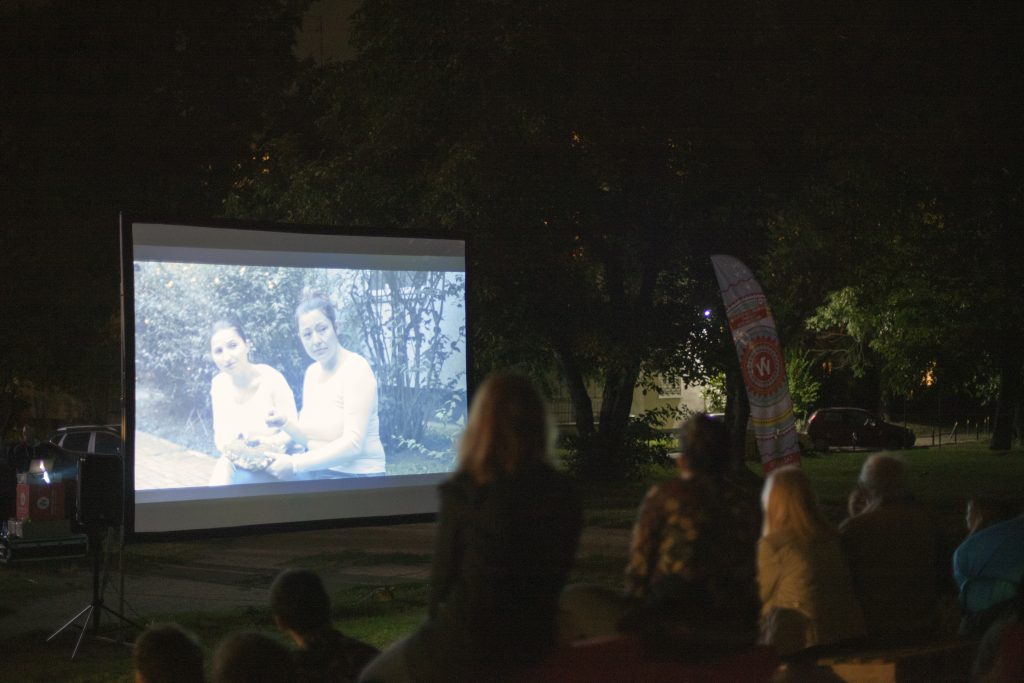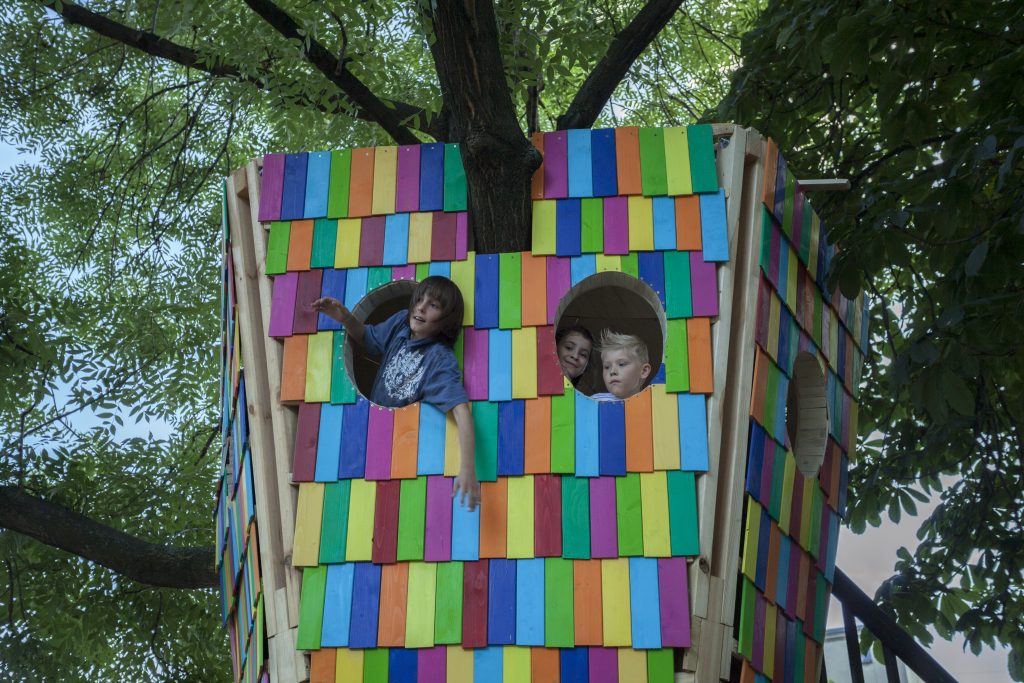
Justyna Wencel and Marcin Chomicki, Labyrinth, Wroclaw – Backyard Door, fot. Justyna Wencel and Marcin Chomicki.
For some time now our eyes have been turned towards Wrocław, assigned to be the European Capital of Culture at the beginning of 2016. We had a look at the artistic scene of the city in our latest print issue and we mentioned a very important project being run in Wrocław: the Wroclaw – Backyard Door. Now that the project is coming to an end, we can look at it and weigh it as a whole and now we would like to present to you, our readers, the ideas behind it. Beginning in 2015 and ending later this year, Backyard Door saw its organisers aim to reanimate the neglected historical areas of Wrocław, and at the same time, stimulate the development of relations between its inhabitants and change and improve their closest surroundings. They want people to stop being limited to their own spaces and for the social life to animate the streets again.
With the project goals in mind a myriad of actions had been undertaken, aimed at the inhabitants and dependent on their will to engage in the changes happening in their closest surroundings. The inhabitants can actively take part in the project, and more importantly, influence the final result of many projects and so make their own decisions about their closest surroundings. The project is to draw neighbours together, to make the forgotten areas of Wrocław attractive again, animate them, and render them into cultural centres.
Some of the works produced by the artists involved are temporary, but others have become a permanent part of the urban space. The event is composed of 20 projects whose common denominator is the idea of strengthening human bonds, the integration of people and their environments, thus rejuvenating and making social relationships more sttractive.

Ewa Błaszak and Zuzanna Wollny, Rainbow, Wroclaw – Backyard Door
The following artists had been invited to help make this a reality in 2015:
Elżbieta Jabłońska, Ołubin (Adoration) organised a survey of ten Wrocław backyards – instructing the inhabitants to produce a detailed quantitative report. This mathematic approach enabled the participants to actively spend a significant number of hours in their daily surroundings while actually contemplating them.
Iza Rutkowska (The Hedgehog) decided to talk to the inhabitants of a housing estate. The process of inhabitants opening up to the artist led to the creation of a ready concept. She decided to create a huge hedgehog mascot comprised of individual elements and left the arrangement of the elements to the inhabitants. Working and having fun together served as an opportunity to meet, talk and tighten neighbourly ties.
Adam Kalinowski (Infinite Green) made a metal and wood flower stand with layered shelves shaped like the symbol for infinity. He finished off his installation with 100 species of evergreens, a choice of composition which was not coincidental.
Dominika Sobolewska (Ziggurat) decided to use a lawn with well-trodden paths and build an installation constructed entirely of benches whose shape was inspired by a Mesopotamian temple. She wanted to provide the inhabitants with a place to meet. The form of the installation highlights the fact that the time spent with your nearest and dearest should be celebrated and sanctified.
NeSpoon (Gateway to everything) is a work comprised of murals with lacework motifs and four lamps placed on the walls by the ceiling. The passage constitutes a gateway to a better world. One should make a wish while crossing it. When someone passes under the gate at night the lamps light up and then switch off by themselves in anticipation of the next person wishing to fight for their dreams.

NeSpoon, Gateway to everything, Wroclaw – Backyard Door, fot. Alicja Kielan
Jacek Zachodny (The Tenement House) When implementing his project, the artist focused on cooperation with the inhabitants and improving the aesthetics of their everyday lives. Together, they renovated a dishevelled backyard, planted a garden and constructed a square shaped like the jin-jang symbol.
Anna Kłos and Daniel Brożek, Lissa (Stories from the backyard) This work aims to show the specific character of the place it describes. The artists created sound recordings of stories weaved by inhabitants which were embellished with other sounds characteristic of the neighbourhood.
Dominik Lejman (We pass each-other by) prepared videos presenting life in the backyard, the way the inhabitants move about in its bounds. The backyard itself served as the screen and the videos were played from the surrounding balconies.
Dominika Borkowska (Lis–TY) chose to use traditional means of communication. Her project involved launching a neighbours’ postal service which could be used by inhabitants to communicate and develop relationships by writing letters to each-other.
Kamila Szejnoch and Krzysztof Żwirblis (Collection), in cooperation with the Ethnographic Museum, organised an exhibition in which you could admire the memorabilia donated by the inhabitants of select tenement houses in Wrocław, which are witnesses to history. The second stage of the project was the transposition of motifs from museum exhibits onto the walls of the near-by houses in the form of graffiti.
2016 saw the following projects flourish:
Cecylia Malik and Niedzielni (A house on an ash-tree) built a tree-house in an urban setting. The project made the backyard more attractive as a place to play with the multicoloured walls of the construction animating the urban setting.
Jakub Szczęsny (Jacobs’ Ladder) let the inhabitants look at their everyday realities from a totally different perspective. The artist set up a ladder in the backyards of Wroclaw’s tenement houses – volunteers could climb up the ladder and watch the surroundings with binoculars.
Ewa Błaszak and Zuzanna Wollny (Rainbow) chose to work in an old unused cinema, which still features in stories told by the elderly members of the community. The result of the project, accomplished in cooperation with the inhabitants of nearby tenement houses, was a film which showcases this old, disused cinema. The word “rainbow” refers to a fairy-tale symbolism.
Kamila Szczęsna (Urban mutations) proposed the creation of lamps from transparent resin, the shape of which was inspired by historic lamps. They were placed in the corridors of tenement houses in one of Wroclaw’s quarters. Kamila wanted to illuminate the neighbourhood, alleviate the feeling of danger, and tighten interpersonal relations.
Karolina Breguła (Neighbourhood series) offered the inhabitants an opportunity to write a screenplay and participate in a series. It tells a fictitious story spread over five episodes and played out against the backdrop of the buildings surrounding the backyard and its nooks and crannies.

Karolina Breguła, Neighbourhood series, Wroclaw – Backyard Door, fot. Alicja Kielan
Joanna Rajkowska (Transformer station) used plants in her project. She planted them in the ruins of a building, leaving notions of architectural structure up to them, to create a new ecosystem and breathing new life into a ruin.
Kozanów (Searching for the miraculous) is a collection of works realised in the urban spaces of a quarter of Wrocław called Kazanów. The project involved both Polish and foreign artists. The idea for this project is a particularly strong calling card for art into urban spaces and their co-creation.
Backyard Door deserves the highest of recognitions; thanks to it art goes out to the world, out to the people. By placing it within familiar, receiver-friendly surroundings, its organisers have made it easier to reach people and be associated with positive things. Due to the timelessness of many projects and the fact of their close integration with the surroundings, art becomes a part of the everyday and people become familiar with it without even fully realising it. Thus, art regains its full importance and kindles more positive attitudes towards it. It stops being an inaccessible, impenetrable, and unfamiliarly cold world, as it is often made to seem in galleries. It becomes a way of integration and of communication.
Translated by Ewa Tomankiewicz

Kamila Szczęsna, Urban mutations, Wrocław – backyard door, fot. Alicja Kielan

Karolina Breguła, Neighbourhood series, Wroclaw – Backyard Door, fot. Alicja Kielan

Cecylia Malik i Niedzielni, A house on an ash-tree, Wroclaw – Backyard Door, fot. Alicja Kielan












